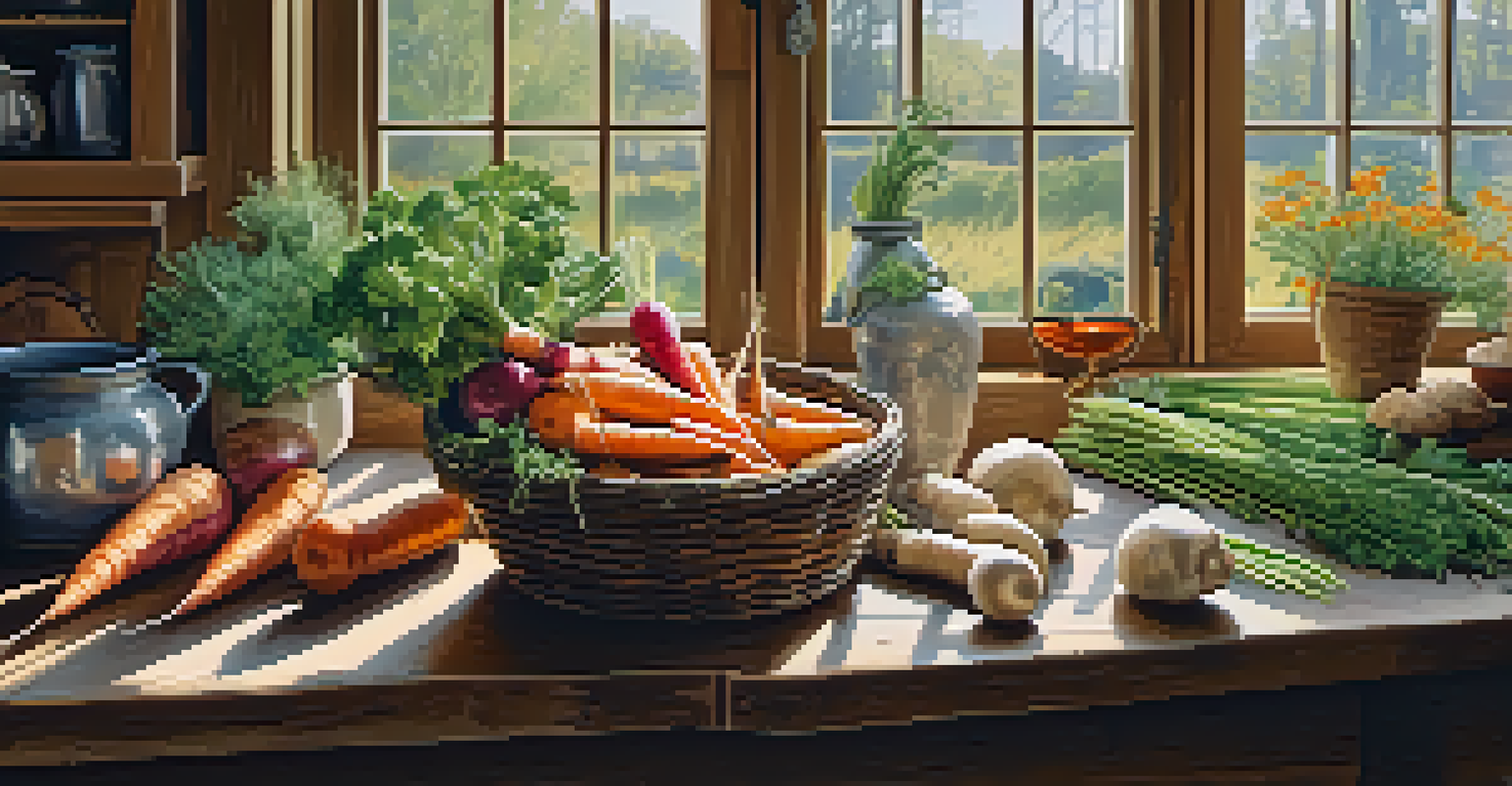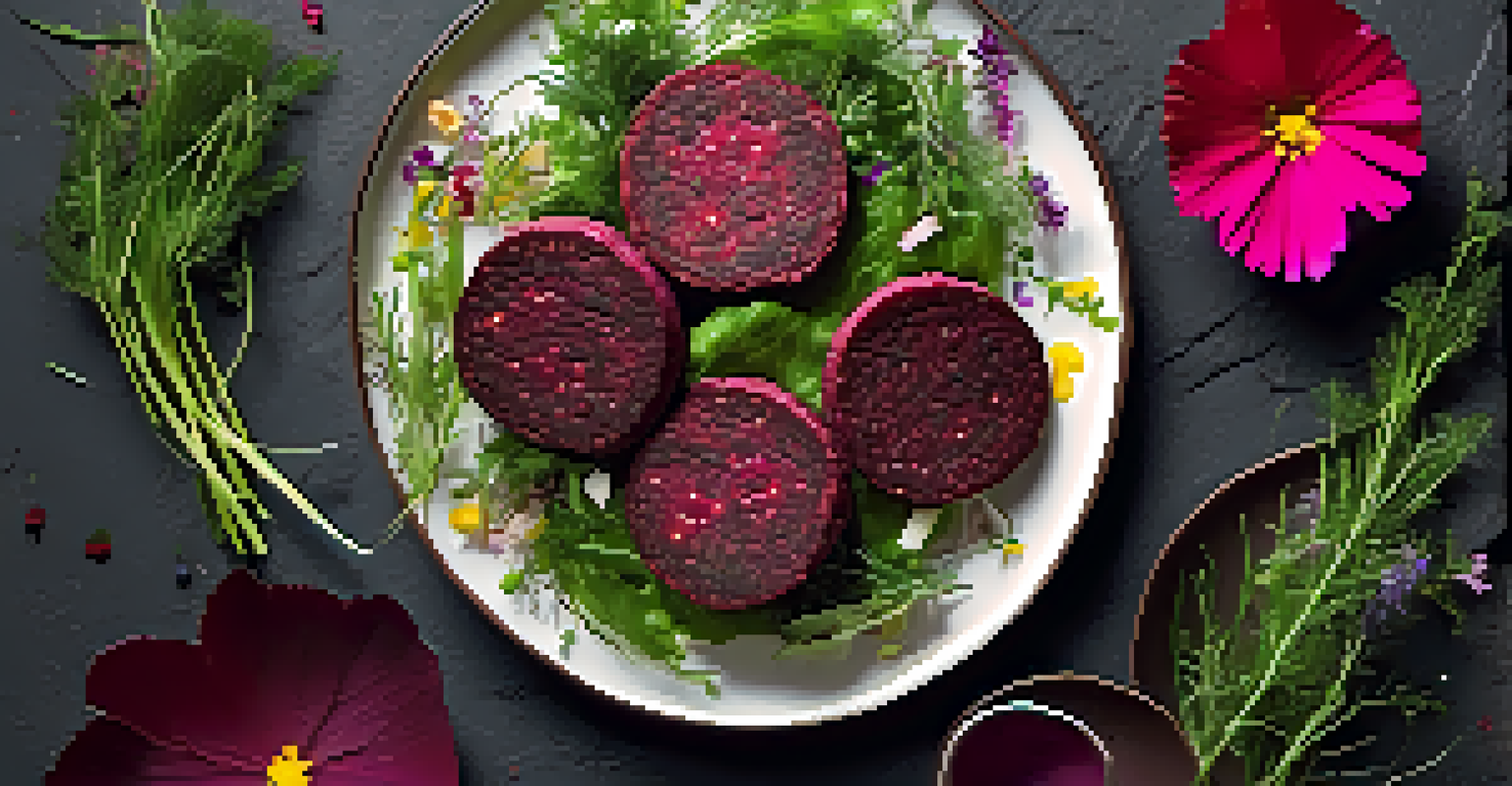Exploring Vegetarian Practices in Nordic Culinary Traditions

The Roots of Nordic Vegetarianism: A Historical Overview
Nordic culinary traditions are deeply rooted in the region's geography and climate, which historically limited agricultural diversity. For centuries, people relied heavily on fish and meat, but the harsh winters and short growing seasons also encouraged creative uses of preserved vegetables and grains. As a result, vegetarian practices began to emerge, particularly among those seeking lighter diets or adhering to various beliefs.
Eating locally and seasonally is not just a trend; it's a way to connect with the land and with our food.
In the past few decades, a shift in dietary habits has brought vegetarianism to the forefront of Nordic cuisine. This change is driven by health trends, environmental concerns, and the growing awareness of animal welfare. As urbanization increases, more people are exploring plant-based options, leading to a revival of traditional vegetarian dishes and the introduction of new ones.
Today, Nordic vegetarianism reflects a fusion of old and new practices. Chefs and home cooks alike are embracing local produce, foraging, and innovative cooking techniques to create vibrant, plant-based meals that honor the region's culinary heritage.
Foraging: A Key Element of Nordic Vegetarian Cuisine
Foraging plays a vital role in Nordic culinary traditions, where nature offers a bounty of edible plants, berries, and mushrooms. This practice not only connects people with their environment but also inspires creativity in vegetarian cooking. Many chefs and home cooks actively seek out wild ingredients, transforming simple dishes into gourmet experiences.

Incorporating foraged ingredients into meals highlights the seasonality and freshness of Nordic cuisine. For example, dishes might include wild garlic in spring, blueberries in summer, or chanterelle mushrooms in autumn. This connection to the land creates a uniquely Nordic flavor profile that elevates vegetarian dishes to new heights.
Nordic Roots of Vegetarianism
Nordic vegetarianism has evolved from historical reliance on fish and meat to embracing plant-based diets driven by health and environmental awareness.
Moreover, foraging promotes sustainability, allowing individuals to utilize local resources responsibly. It fosters a deeper appreciation for nature and encourages mindful eating, which aligns perfectly with the principles of vegetarianism.
Seasonal Vegetables: The Heart of Nordic Vegetarian Dishes
Seasonal vegetables are at the core of Nordic vegetarian cuisine, providing freshness and flavor throughout the year. Root vegetables such as potatoes, carrots, and turnips are staples during the colder months, while summer brings an abundance of vibrant greens and colorful produce like tomatoes and peppers. This variety allows for diverse and exciting vegetarian meals that change with the seasons.
Food is not just what we eat; it's a reflection of who we are and where we come from.
Chefs often emphasize the importance of using locally sourced ingredients to support regional farmers and reduce environmental impact. Dishes might feature a simple roasted root vegetable medley or more elaborate preparations like pickled or fermented vegetables, which enhance flavors and preserve the harvest.
By embracing seasonal cooking, Nordic vegetarian cuisine not only celebrates the unique offerings of each time of year but also encourages a more sustainable lifestyle. This approach resonates with those seeking healthier diets while minimizing their ecological footprint.
Traditional Nordic Dishes Reimagined as Vegetarian Options
Many traditional Nordic dishes have undergone a transformation to accommodate vegetarian diets. Iconic meals such as 'grönsaksbullar' (vegetable balls) and 'rödbetsbiffar' (beet patties) are gaining popularity as flavorful alternatives to their meat-based counterparts. These reimagined dishes retain the essence of their origins while catering to modern tastes and dietary preferences.
Chefs are also experimenting with plant-based versions of classic recipes, such as a vegetarian 'smörgåsbord' featuring an array of seasonal salads, pickled vegetables, and hearty grain dishes. This creative approach allows for a diverse and satisfying dining experience, showcasing the versatility of vegetarian ingredients.
Foraging Enhances Nordic Cuisine
Foraging for wild ingredients not only connects cooks with nature but also elevates the freshness and creativity of Nordic vegetarian dishes.
As more people embrace plant-based diets, these reinterpretations of traditional dishes not only preserve cultural heritage but also promote inclusivity in Nordic cuisine. This evolution illustrates how culinary traditions can adapt and thrive in a changing world.
The Role of Local Ingredients in Nordic Vegetarian Cooking
Local ingredients are the backbone of Nordic vegetarian cooking, highlighting the importance of regional produce and sustainability. Farmers' markets and community-supported agriculture programs have become increasingly popular, providing access to fresh, organic vegetables and grains. This focus on local sourcing allows cooks to create dishes that reflect the unique flavors of their surroundings.
Incorporating local ingredients not only supports the economy but also enhances the taste and nutritional quality of meals. For instance, using freshly harvested kale or heirloom carrots can make a significant difference in both flavor and texture, elevating even the simplest vegetarian dishes.
Moreover, this commitment to local sourcing fosters a sense of community and connection among consumers and producers. It encourages conversations about food origins and promotes awareness of seasonal eating, which aligns well with the principles of sustainable vegetarianism.
Innovative Cooking Techniques in Nordic Vegetarian Cuisine
Nordic chefs are well-known for their innovative approach to cooking, often employing techniques that transform the way we think about vegetarian meals. Methods like fermentation, smoking, and pickling are frequently used to enhance flavors and preserve seasonal ingredients. These techniques not only add depth to dishes but also reflect the region's culinary heritage.
For example, fermented foods, such as 'surkål' (fermented cabbage), are staples in Nordic diets and provide a unique tangy flavor that complements many vegetarian dishes. Similarly, smoking vegetables can impart a rich, complex taste, making even the simplest ingredients feel special.
Local Ingredients Drive Flavor
Using locally sourced ingredients in Nordic vegetarian cooking supports sustainability and enhances the taste and nutritional quality of meals.
These innovative methods encourage exploration and experimentation in vegetarian cooking, inspiring home cooks to think outside the box. By embracing these techniques, one can create a diverse array of dishes that celebrate the flavors and traditions of the Nordic region.
The Future of Vegetarianism in Nordic Cuisine
As the world becomes increasingly aware of the benefits of plant-based diets, the future of vegetarianism in Nordic cuisine looks promising. With more chefs and home cooks embracing sustainable practices and innovative cooking techniques, the culinary landscape is evolving. This shift is not only about health and wellness but also about conserving the environment and supporting local communities.
The rise of vegetarian-friendly restaurants and cafes across Nordic countries is a testament to this growing trend. Diners are increasingly seeking out plant-based options, prompting establishments to craft menus that highlight seasonal vegetables and local ingredients. This demand encourages chefs to push boundaries and explore new flavors, helping to redefine Nordic cuisine.

Ultimately, the future of vegetarianism in Nordic culinary traditions is about balance—merging the rich heritage of the region with contemporary values and tastes. This evolution has the potential to create a vibrant, inclusive food culture that resonates with both locals and visitors alike.